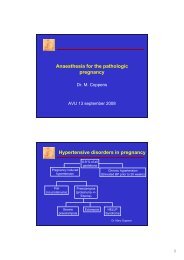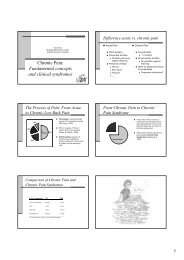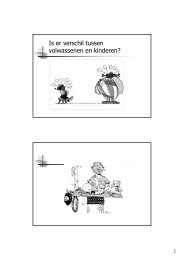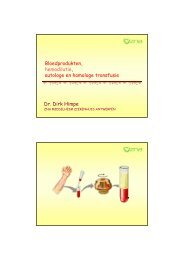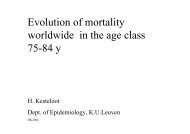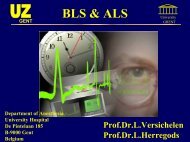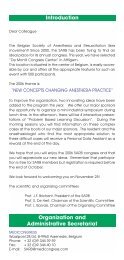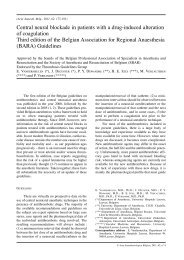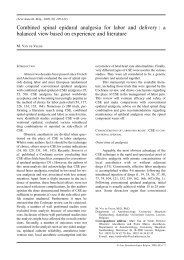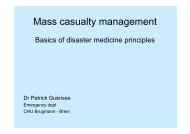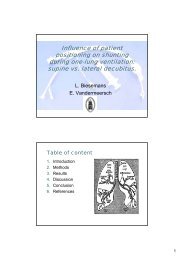Obesity the metabolic syndrome
Obesity the metabolic syndrome
Obesity the metabolic syndrome
You also want an ePaper? Increase the reach of your titles
YUMPU automatically turns print PDFs into web optimized ePapers that Google loves.
<strong>Obesity</strong><br />
and<br />
<strong>the</strong> <strong>metabolic</strong> <strong>syndrome</strong><br />
Dr. Luc De Baerdemaeker<br />
Department of Anaes<strong>the</strong>sia<br />
University Hospital<br />
Ghent University<br />
Misses and mister chairmen, dear collegues,<br />
<strong>Obesity</strong> is worldwide on <strong>the</strong> move. More and more patients undergo some form<br />
of bariatric surgery in order to lose weight and by doing so <strong>the</strong>y are trying to<br />
reduce <strong>the</strong>ir morbidity and mortality caused by obesity.<br />
Most anes<strong>the</strong>siologists will consider morbidly obese patients as high risk. NEXT<br />
1
Can bariatric surgery be<br />
performed in short(er) stay ?<br />
Why not day case surgery ?<br />
Since this year topic is anes<strong>the</strong>sia and shorter stay <strong>the</strong> main question of this<br />
presentation will be we<strong>the</strong>r morbidly obese patients are good candidates for short<br />
stay or why not even day case surgery and in what way can <strong>the</strong> anes<strong>the</strong>siologist<br />
contribute to achieve this.…<br />
2
Outpatient laparoscopic gastric banding:<br />
initial experience<br />
De Waele et al. <strong>Obesity</strong> surgery 2004; 14(8): 1108-10<br />
• BMI > 35kg/m 2 , living near hospital, adult companion<br />
• 9 women, 1 man: mean age 36 (18-52)<br />
mean BMI 38.4(35.1-43.3)<br />
• ASA II<br />
• Co-morbidities: functional dyspnea, osteoarthritis,<br />
hypertension, type 2 diabetes, dyslipidemia<br />
• Mean operating time 87min (65-115)<br />
• Mean time (end surgery-discharge) 9.6 hrs<br />
• No readmisions and no complications at 1 month<br />
• High patient satisfaction<br />
In recent literature, more and more publications are pointing out that this idea<br />
might be feasible. I have picked out 2 studies.<br />
Laparoscopic gastric banding has usually been performed on an inpatient<br />
procedure with average hospital stays of 2-4 days.<br />
The aim of this study from our collegues of <strong>the</strong> VUB was to assess <strong>the</strong><br />
feasability of LAGB as an ambulatory procedure in selected patients.<br />
Zie tekst voor inclusie en resultaten<br />
The conclusion was that this study demonstrates that LAGB may be performed<br />
on ambulatory basis without complications<br />
3
Two-day length of stay following open Roux-en-Y<br />
gastric bypass: is it feasible, safe and reasonable ?<br />
Stellato et al. <strong>Obesity</strong> Surgery 2004;14(1):27-34<br />
• Retrospective study 1998-2002<br />
• N=316, mean BMI 52.3, no differences in comorbidities or BMI<br />
• Discharge criteria included oral intake, pain control, written test for<br />
understanding of <strong>the</strong> operation<br />
• Operative time 1998: 241 min<br />
2002: 156 min<br />
• Discharge at 2 days 1998: 0%<br />
1999: 0%<br />
2000: 2%<br />
2001: 15%<br />
2002: 50% with 4.1% 30-d readmission<br />
• Multidisciplinary approach since 2001<br />
• Aggressive preoperative education and screening has to be performed<br />
This is a retrospective study performed at <strong>the</strong> university hospitals of cleveland.<br />
316 patient underwent open roux en y gastric bypass in this period. Important to<br />
notice is <strong>the</strong> start of a multidisciplinary approach in 2001 and <strong>the</strong> decline in<br />
operating time. The conclusion was that discharge at day 2 can be safe provided<br />
that agressive preoperative education and screening is performed.<br />
4
6 Predictors of prolonged hospital stay in<br />
open and laparoscopic gastric bypass<br />
• Open surgery<br />
• High BMI<br />
• Increasing length of surgery<br />
• Sleep apnea disorders<br />
• Asthma<br />
• hypercholesterolemia<br />
Ballantyne et al. <strong>Obesity</strong> surgery 2004;14(8):1042-50<br />
The authors of this retrospective study of 311 patients performed at <strong>the</strong> bariatric<br />
surgery center somewhere in <strong>the</strong> USA,<br />
Managed to identify 6 predictors of increased length of stay following open or<br />
laparoscopic roux en y gastric bypass.<br />
5
Patients with <strong>the</strong> greatest odds for<br />
longer stay<br />
• Men with sleep apnea 5.54 OR<br />
• Men with <strong>the</strong> <strong>metabolic</strong> <strong>syndrome</strong> 6.67-10.2 OR<br />
• Women with asthma 3.73 OR<br />
• Women with coronary artery disease 8.65 OR<br />
• Laparoscopy in patients with<br />
Sleep apnea<br />
11.53 OR<br />
• Laparoscopy in patients with<br />
coronary artery disease<br />
12.15 OR<br />
Ballantyne et al. <strong>Obesity</strong> surgery 2004;14(8):1042-50<br />
Subset analysis identified patients with <strong>the</strong> greatest odds of longer hospital stay.<br />
6
The <strong>metabolic</strong> <strong>syndrome</strong><br />
The deadly quartet<br />
• Constellation of abdominal obesity<br />
• Hypertension<br />
• Diabetes<br />
• Dyslipidemia<br />
Clinical implications:<br />
• Increased risk of coronary artery disease<br />
• Increased risk of non-alcoholic steatotic hepatitis<br />
(NASH)<br />
The constellation of abdominal obesity, hypertension, diabetes and dyslipidemia<br />
has been called <strong>the</strong> <strong>metabolic</strong> <strong>syndrome</strong>, <strong>syndrome</strong> X, <strong>the</strong> deadly quartet, <strong>the</strong><br />
insulin resistance <strong>syndrome</strong>, and <strong>the</strong> obesity dyslipidemia <strong>syndrome</strong>. The clinical<br />
implications are that individualsz with <strong>the</strong> <strong>metabolic</strong> <strong>syndrome</strong> have an increase<br />
risk of coronary artery disease and <strong>the</strong> development of non alcoholic steatotic<br />
hepatitis NASH<br />
7
Are obese patients at higher risk of<br />
surgical and post-operative<br />
complications ?<br />
• Obese do have more wound infections<br />
• The regressive attitude in referring<br />
morbidly obese patients for surgery or<br />
denying surgery to such patients should be<br />
reconsidered<br />
Dindo et al. The Lancet vol 361.june 14,2003:2032-35<br />
This article in <strong>the</strong> lancet compared <strong>the</strong> overall mortality and morbidity after<br />
surgery between obese and lean patients and found as a major conclusion that<br />
wound infection are more frequent in <strong>the</strong> obese probably due to altered<br />
microcirculation but compared to lean patietns post operative complications were<br />
simular. So this report seems to confirm <strong>the</strong> findings in <strong>the</strong> previous studies. The<br />
author clearly states that it is time <strong>the</strong> mecdical world changes its attitude towards<br />
<strong>the</strong>se patients.And I quote literally: <strong>the</strong> …….<br />
8
Is extensive preoperative testing<br />
necessary in morbidly obese<br />
patients?<br />
• Apparently not<br />
Ramaswary et al. Journal of gastrointestinal surgery 2004;8(2):159-165<br />
Routine tests: Complete blood count<br />
Electrolytes<br />
ECG<br />
Anemia studies<br />
For selected patients: coagulation testing<br />
chest X-ray<br />
cardiac stress tests<br />
pulmonary function tests<br />
Screening obese patients is important but how far do we have to go ? According<br />
to this study not that far.<br />
9
Is extensive preoperative testing necessary in<br />
morbidly obese patients?<br />
Ramaswary et al. Journal of gastrointestinal surgery 2004;8(2):159-165<br />
Chest X-ray 4% abnormal<br />
ECG<br />
15% abnormal<br />
Spirometry 21% abnormal<br />
Asthma and high BMI predictive factors<br />
Echocardiography 2 % abnormal<br />
previous cardiac disease predictive factor<br />
No intervention needed<br />
. Full screening consisted of chest X ray, pulmonary fuction testing, ECG and<br />
dobutamine stress test. Blood work included ABG, Blood count, thyroid function<br />
tests and anemia studies on iron and vit B12.<br />
10
Circulation 2002;105:1257-67<br />
In 2OO2, The american heart assoaciates updated <strong>the</strong>ir guidelines for <strong>the</strong><br />
perioperative evulaation of cardiovascular risk for non-cardiac surgery. Time is<br />
to limited to go through all <strong>the</strong> details.<br />
11
But took a look at <strong>the</strong> major clinical predictors of cardiovascular risk and you<br />
will see that obesity is not one of <strong>the</strong>m.<br />
12
In <strong>the</strong> surgical procedures as risk predictor <strong>the</strong> only hint we get is in <strong>the</strong><br />
intermediate and low risk indicators<br />
13
But <strong>the</strong> american heart association did stress out on <strong>the</strong> functional capacity of <strong>the</strong><br />
patietn expressed as METABOLIC EQUIVALENTS.<br />
IN <strong>the</strong>ir flow chart any patient with a score less <strong>the</strong>n 4 MET is to be considered<br />
high risk and should could a cardiac work out.<br />
14
The New England Journal of Medicine 1999 ;340: 937-944<br />
Current Concepts: Preoperative Pulmonary Evaluation<br />
Gerald W. Smetana<br />
Factors contributing to respiratory complications<br />
– patient related Smoking<br />
poor exercise capacity<br />
general health status<br />
COPD / Asthma<br />
– procedure related distance from diaphragm<br />
> 3 hours surgery<br />
Locoregional anaes<strong>the</strong>sia<br />
use of long acting muscle relaxant<br />
NO OBESITY !<br />
The same can be applied to spirometry.<br />
15
The New England Journal of Medicine 1999 ;340: 937-944<br />
Current Concepts: Preoperative Pulmonary Evaluation<br />
Gerald W. Smetana<br />
Pre-operative pulmonary-function testing<br />
• spirometry has a variable predictive value, remains controversial<br />
• Clinical findings are more predictive <strong>the</strong>n spirometry<br />
Odds Ratio of 5.8 vs. 1.0<br />
• PaCO 2 > 45 mmHg is a strong risk factor<br />
Criteria<br />
• FEV 1 < 70% predicted value<br />
• FVC < 70% predicted value<br />
• FEV 1 /FVC < 65%<br />
Increased risk for<br />
pulmonary complications<br />
16
The New England Journal of Medicine 1999 ;340: 937-944<br />
Current Concepts: Preoperative Pulmonary Evaluation<br />
Gerald W. Smetana<br />
Who should get a spirometry ?<br />
• Patients undergoing thoracic or upper abdominal<br />
surgery with unexplained symptoms of:<br />
– cough<br />
– dyspnea<br />
– exercise intolerance<br />
• COPD / Asthma<br />
17
The New England Journal of Medicine 1999 ;340: 937-944<br />
Risk-reduction strategies<br />
Preoperative stop smoking > 8 weeks<br />
treat airflow obstruction<br />
treat respiratory infection and delay surgery<br />
educate patient regarding lung expansion<br />
intraoperative < 3 hrs surgery<br />
locoregional anes<strong>the</strong>sia<br />
avoid pancuronium<br />
laparoscopic procedures when possible<br />
postoperative deep breathing exercises or incentive spirometry<br />
CPAP<br />
epidural analgesia<br />
18
Patient selection in ambulatory anes<strong>the</strong>sia<br />
an evidence based review part 1-2<br />
Bryson et al; CAN J ANESTH 2004;51:768-94<br />
• OSAS: wear nasal CPAP<br />
non opioid analgesia, avoid opioids<br />
• Morbid obesity:<br />
respiratory risks have to be recognized and<br />
managed<br />
• Diabetes:<br />
metformin withdraw not supported by evidence<br />
tighter perioperative glucose control<br />
half dose adminstered as intermediate duration insulin<br />
You might have noticed that most studies so far were publishid in surgery<br />
journals. This very recent publication evaluates <strong>the</strong> managment of patients with<br />
selected medical conditions undergoing ambulatory anes<strong>the</strong>sia and surgery.<br />
19
Pre-op evaluation<br />
• Careful history taking and physical examination<br />
• look for signs of symptoms of sleep apnea<br />
difficult intubation<br />
Mallampati score<br />
Neck circumference > 40<br />
Short thyromental distance<br />
hypognathia<br />
upper lip bite test<br />
20
Upper lip bite test<br />
2003;96:595-99<br />
from Kahn et al. AA<br />
21
Upper lip bite test<br />
2003;96:595-99<br />
from Kahn et al. AA<br />
22
Symptoms of sleep apnea<br />
• Presence of loud, habitual snoaring<br />
• episodes of apnea witnessed by a bed partner<br />
• episodes of nocturnal choking or gasping<br />
• daytime hypersomnolence<br />
Known associations:<br />
•BMI > 30<br />
• Orofacial or pharyngeal abnormalities<br />
23
RESPONSE TO CO 2<br />
• OSAS: OBSTRUCTIVE SLEEP APNEA SYNDROME<br />
30 apneic periods > 20 sec over 7 hours<br />
• OHS: OBESITY HYPOVENTILATION SYNDROME<br />
OSAS + hypoxemia<br />
hypercapnia<br />
pulmonary hypertension<br />
hypersomnolence<br />
• PICKWICKIAN SYNDROME: described in 1837 by CH.<br />
Dickens<br />
OHS +<br />
polycy<strong>the</strong>mia<br />
biventricular failure<br />
24
OSAS<br />
• Incidence in obese women 3-25%<br />
obese men 40-78%<br />
• Caused by<br />
abundant peripharyngeal adipose tissue<br />
abnormal upper airway tone during<br />
REM sleep<br />
25
Why is detection of OSAS<br />
important?<br />
• OSA patients are more sensitive to <strong>the</strong><br />
depressant effects of hypnotics and opioids<br />
• OSA is associated with difficult<br />
laryngoscopy and difficult mask ventilation<br />
26
Detection of OSAS<br />
• Polysomnographic testing in sleep lab<br />
• (not reliable) predictive tools<br />
–History<br />
– Systemic hypertension<br />
– Neck circumference > 40 cm<br />
– Malampatti score 3-4, hypognathia, short<br />
thyromental distance<br />
27
OSAS: PACU or ICU ?<br />
28
conclusion<br />
• Bariatric surgery can be performed in<br />
short(er) stay and sometimes day case<br />
• Extensive preoperative testing is not<br />
necessary<br />
• But patient selection is important<br />
• But nobody mentioned anes<strong>the</strong>sia<br />
technique!!!<br />
29
Risk of morbidly obesity<br />
• Aspiration of gastric content<br />
• difficult intubation<br />
• sleep apnea<br />
• co morbidity<br />
• respiratory complications<br />
• right heart failure<br />
• anatomic considerations<br />
• farmacological considerations<br />
30
Pathophysiology<br />
Haemodynamic changes<br />
• Pre-afterload<br />
• MPAP<br />
• RVSW,LVSW<br />
• Cardiac diameter<br />
• CO<br />
• SV<br />
• Left ventricular function<br />
• arterial hypertension +<br />
The cardiac diameter is usually 20-55% increased, autopsy studies demonstrate<br />
ventricular hypertrophia and increased cardiac weight.<br />
Increased CO is Due to A Incresed SV; CO is correlated to weight and<br />
proportional to <strong>the</strong> increased oxygen consumtion in morbid obesity.<br />
Agarwal et al. Found that left ventricular function in asymptomatic morbidly<br />
obese patients was 57% of normal values. De Divitiis et all published in<br />
Circulation 198O a report of depressed left and right ventricular function<br />
assessed by left and right ca<strong>the</strong>terisation in relatively young asymptomatic obese<br />
patients.<br />
Hypertension coorelates well with obesity. Probably due to <strong>the</strong> fact that <strong>the</strong> high<br />
CO is forced into an arterial system with unaltered SVR.<br />
The Framingham study showed a positive correlation between £Angina pectoris,<br />
sudden death and obesity but not with AMI.<br />
31
<strong>Obesity</strong> and heart failure<br />
Kenchaiah et al.N.Engl.J.Med.2002Vol.347,n°5: 305-13<br />
32
Pathophysiology<br />
Respiratory changes<br />
PULMONARY<br />
MECHANICAL<br />
• chestwall compliance<br />
• lung compliance<br />
• total resp. compliance<br />
• FRC due to ERV<br />
• FRC decreases from<br />
standing to Trendlenburg<br />
• Danger zone: FRC = CV<br />
airway closure<br />
. .<br />
V/Q mismatch<br />
The respiratory changes can be differentiated in mechanical and pulmonary<br />
changes<br />
The decrease in chest wall compliance is caused by <strong>the</strong> fat accumulation around<br />
<strong>the</strong> ribs, diaphragm and intra abdominal cavity.<br />
The increased pulmonary blood volume is responsible for <strong>the</strong> decrease in lung<br />
compliance.<br />
Both result in a decrease of total respiratory compliance.<br />
The FRC is decreased due to a decreased ERV. Why is FRC so important to <strong>the</strong><br />
Anaes<strong>the</strong>siologist? First off all, By refreshing <strong>the</strong> FRC with 100% Oxygen, we<br />
can give <strong>the</strong> patient an oxygen reservoir,necessary to maintain adequat<br />
oxygenation during <strong>the</strong> induction apnea. Secondly, IF <strong>the</strong> FRC decreases fur<strong>the</strong>r<br />
to <strong>the</strong> point of µClosing volume, more and more airway collaps will occur in<br />
depentdent lung regions, giving rise to fur<strong>the</strong>r ventilation/ perfusion mismatch,<br />
shunting in o<strong>the</strong>r words. The result will be a negative effect an arterial pO2.<br />
It is important to point out that bringing <strong>the</strong> patient in a supine or Trendlenburg<br />
position will cause a fur<strong>the</strong>r decrease in FRC.<br />
33
Morbid <strong>Obesity</strong> and Postoperative Pulmonary Atelectasis: An<br />
Underestimated Problem<br />
A.- S. Eichenberger et al.<br />
Anesth Analg 2002;95:1788-92<br />
MO patients will develop much more atelectasis, which will persist and even tend to increase,<br />
24 hours after tracheal extubation<br />
34
How to get rid of atelectasis<br />
• pre-oxygenation with FIO 2 0.8 ??<br />
• Pre-oxygenation with CPAP (5 min) and even<br />
application of PCV (< 20 cm H 2 O) and PEEP (5<br />
min) via a face mask during induction<br />
• Before extubation: vital capacity manoever and<br />
avoiding FIO 2 of 1.0 !!<br />
• PEEP during surgery<br />
• post-op: sitting position<br />
CPAP or BIPAP<br />
35
1.00 or 0.8 FIO 2 for induction ?<br />
36
CPAP at induction<br />
CF 800<br />
Continuous flow CPAP system for a wide application<br />
range. Bellow reservoir ensures an effective <strong>the</strong>rapy<br />
with constant pressure at a small flow.<br />
37
CPAP and mask ventilation during induction<br />
Prevention of atelectasis formation during <strong>the</strong> induction of general<br />
anes<strong>the</strong>sia in morbidly obese patients<br />
Coussa et al Anesth Analg 2004;98:1491-5<br />
VCV: Vt 10ml/kg IBW freq 10/min<br />
38
CPAP and mask ventilation during induction<br />
Prevention of atelectasis formation during <strong>the</strong> induction of general<br />
anes<strong>the</strong>sia in morbidly obese patients<br />
Coussa et al Anesth Analg 2004;98:1491-5<br />
CPAP 0 cmH 2 O<br />
and PEEP 0 cmH 2 O<br />
CPAP 10 cmH 2 O<br />
and PEEP 10 cmH 2 O<br />
39
Mechanical Versus Manual Ventilation via a Face Mask During <strong>the</strong><br />
Induction of Anes<strong>the</strong>sia: A Prospective, Randomized, Crossover<br />
Study<br />
Achim von Goedecke et al. Anasth Analg 2004;98:260-3<br />
Hemodynamic and Respiratory Characteristics in 41 Patients During<br />
Pressure-Controlled Ventilation (PCV) and Circle System Ventilation (CSV)<br />
Variable PCV CSV P value<br />
Heart rate (bpm) 69 ± 13 70 ± 11 NS<br />
Mean arterial blood pressure (mm Hg) 78 ± 8 78 ± 11 NS<br />
Oxygen saturation (%) 98 ± 1 98 ± 1 NS<br />
End-tidal carbon dioxide (mm Hg) 34 ± 3 33 ± 4 NS<br />
Respiratory rate (breaths/min) 15 ± 0 15.4 ± 1 0.015<br />
Expiratory tidal volume (mL) 650 ± 100 680 ± 100 0.001<br />
Minute ventilation (L/min) 10.4 ± 1.8 11.6 ± 1.8
Extubation on 100% oxygen ?<br />
The Effect of Increased FIO 2 Before Tracheal Extubation on<br />
Postoperative Atelectasis<br />
Benoît et al. Anesth Analg 2002;96:1777-81<br />
FIO 2 100 with and<br />
without VCM<br />
FIO 2 0.4 + VCM<br />
VCM= manual inflation of <strong>the</strong> intubated patient’s lungs to 40 cm H 2 Ofor15 s<br />
41
Does PEEP make sense ?<br />
It sure does !<br />
5-8 cm H 2 O<br />
42
Should obese patients be considered as<br />
non fasting ?<br />
Risk factors for aspiration of gastric content in Obese<br />
• abnormal gastric emptying<br />
• large gastric content after fasting ??<br />
• low gastric pH (< 2.5)<br />
• increased abdominal pressure<br />
• lower oesopohageal sfincter pressure<br />
• association of obesity and gastro-oesophageal reflux<br />
• Increased prevalence of hiatal hernias in <strong>the</strong> obese<br />
43
What about Gastric aspiration<br />
risk AFTER bariatric surgery ??<br />
• REDO gastric banding or slippage of band<br />
!!<br />
• Gastric emptying for solid food is delayed<br />
• Differential effects of bariatric procedures<br />
on gastric emptying<br />
• Gastric emptying patterns change over time<br />
as patients lose weight<br />
Patients having undergone gastric reduction have an spiration risk that is not very<br />
well understood. Studies with Radionuclide labeled material showed that gastric<br />
emptying of solid food is delayed up to 3 month after surgery. After 12 months<br />
emptying was faster <strong>the</strong> pre surgery values. But different barriatric procedures<br />
have differentioal effects on gastric pouch emptying. Surgery with truncal<br />
vagotomy will reduce <strong>the</strong> acitdity of <strong>the</strong> gastric contetn but will also stimulate<br />
bacterial overgrowth and decrease <strong>the</strong> mobility of <strong>the</strong> stomach. As patients start<br />
to loose weight, <strong>the</strong>ir gastric emptying pattern also changes!!<br />
Patients with Redo gastric banding or slippage of <strong>the</strong> band usually have a dilated<br />
or decompensated oesophagus filled with food residuesand definetely pose a high<br />
risk of aspiration.<br />
44
Haemodynamic problems during<br />
laparoscopy<br />
•SVR<br />
•MAP<br />
• Myocardial filling pressures<br />
• CI up to 50%<br />
•HR =<br />
Joris et al. Anes<strong>the</strong>sia Analgesia 1994;76:1067<br />
changes are phasic<br />
45
Factors influencing Haemodynamic respons<br />
during laparoscopy<br />
• Intra-abdominal pressure > 12 mmHg<br />
• patient position<br />
• CO 2 absorption<br />
• ventilatory strategy<br />
• surgical technique<br />
• intravascular volume<br />
• pre-existing cardiopulmonary status<br />
• neurohormonal factors<br />
• medication and anaes<strong>the</strong>tics<br />
46
Regional circulatory Changes<br />
• Cerebral ICP CBF<br />
• liver flows<br />
•Bowel pHi splanchnic perfusion<br />
• Kidney arterial-, venous-,cortical flow<br />
> 15 mmHg IAP, use of warm CO 2<br />
• lower limbs venous flow<br />
IMPACT in critically ill patients !<br />
47
Dumont;Mattys;Mardirosoff;Picard <strong>Obesity</strong> Surgery 1997; 7:326-331<br />
Hemodynamic Changes During Laparoscopic Gastroplasty in<br />
Morbidly Obese Patients<br />
Laparoscopic procedures are safe<br />
for Morbidly Obese Patients<br />
48
Pre medication<br />
• Short acting Benzodiazepine<br />
e.g. midazolam, lorazepam<br />
•H 2 antagonist e.g.<br />
ranitidine 150 mg PO or 50 mg IV<br />
1hr before surgery<br />
49
PHARMACOKINETICS<br />
PHARMACODYNAMICS<br />
• WATER-SOLUBLE COMPOUNDS: V d =, CL =<br />
• LIPOPHILIC DRUGS V d<br />
• PHASE 1 METABOLISM ( ox, red ): =<br />
• PHASE 2 CONJUGATION PATH: incr<br />
• BENZODIAZEP., THIOPENTAL: V d incr, Cl =, T 1/2<br />
• PROPOFOL: bolus dose on IBW<br />
infusion: V d =, Cl =, T 1/2 =<br />
• FENT: V d =, Cl =, SUF: V d incr, CL =, ALFENT: V d =, Cl<br />
• SUCCINYLCHOLIN:<br />
1.5 mg/kg<br />
• MIVACURIUM, ATRACURIUM: recovery =<br />
• PANCURONIUM, VECURONIUM: recovery<br />
50
Pharmacology<br />
•Use <strong>the</strong> Ideal Body Weight (IBW) !<br />
• How to calculate IBW ?<br />
– from nomograms e.g. metropolitan life insurance<br />
– MEN Bodylength cm - 100 = IBW kg<br />
WOMEN Bodylength cm - 105 = IBW kg<br />
• Succinylcholine: dosage on real body mass<br />
The problem of pharmacokinetics and dynamics can be easily solved. For <strong>the</strong><br />
major anaes<strong>the</strong>tic agents, <strong>the</strong> pharmacokinetics in morbid obees patients<br />
resemble those of lean persons if <strong>the</strong> LBM is used. This goes for <strong>the</strong> major<br />
hypnotic agents, <strong>the</strong> opioids and <strong>the</strong> muscle relaxants. There is one exception in<br />
<strong>the</strong> form off succinylcholine, here <strong>the</strong> real body mass has to be used to calculate<br />
<strong>the</strong> dosage.<br />
There are many rules and formulas to calculate <strong>the</strong> LBM, but this rule is <strong>the</strong> most<br />
easy one in my experience.<br />
51
Does size matter?<br />
Buoillon T., Shafer SL.<br />
Anes<strong>the</strong>siology 1998;89(3):557-60<br />
52
propofol<br />
thiopental<br />
midazolam<br />
Vecuronium<br />
Atracurium<br />
Cisatracurium<br />
Rocuronium<br />
Succinylcholine<br />
Mivacurium<br />
neostigmine<br />
alfentanil<br />
sufentanil<br />
remifentanil<br />
Induction IBW<br />
Maintenance TBW or<br />
IBW+0.4 x excess weight<br />
7.5 mg/kg IBW<br />
TBW<br />
TBW for initial dose<br />
IBW for continuous dose<br />
IBW<br />
TBW<br />
Initial dose .15 mg/kg – 2.3mg/10kg>70kg<br />
Supplemental dose .15mg/kg – 0.7mg/10kg>70kg<br />
TBW<br />
IBW<br />
IBW<br />
TBW<br />
>140 kg: max of 120-140mg<br />
TBW<br />
TBW<br />
IBW<br />
IBW+0.4 x excess weight<br />
TBW<br />
TBW<br />
IBW+0.4 x excess weight if BMI>40<br />
IBW<br />
Kirby,Redfern,Gepts<br />
Servin<br />
Gepts<br />
Buckley<br />
Jung<br />
Greenblatt<br />
Reves<br />
Schwartz<br />
Varin, Weistein<br />
Kirkegaard nielsen<br />
Schmith,Kisor<br />
Leykin<br />
Puhringer, Leykin<br />
Bentley,Rose<br />
Cooper, Brodsky<br />
Pino, Patel<br />
Kirkegaard-Nielsen<br />
Bentley<br />
Salihoglu<br />
Maître<br />
Schwartz,Gepts<br />
Schlepchenko<br />
Minto, Egan<br />
53
Juvin et al. Anes<strong>the</strong>sia Analgesia 2000;91:714-9<br />
Postoperative Recovery After Desflurane, Propofol<br />
or Isoflurane Anes<strong>the</strong>sia Among Morbidly Obese<br />
Patients: A Prospective, Randomized Study<br />
Advantage of desflurane<br />
– predictable and rapid recovery<br />
– reduction in postoperative hypoxemia<br />
– increase in patient mobility<br />
54
Application of TCI models in <strong>the</strong> obese<br />
PROPOFOL<br />
• Propofol does not accumulate in morbidly obese patients.<br />
Maintenance dosage is <strong>the</strong> same as in normal patients<br />
Servin et al Anes<strong>the</strong>siology 1993;78(4):657-65<br />
• Marsh kinetics ( diprifusor®) was not developped<br />
for morbidly obese<br />
use corrected body weight<br />
corrected body weight = IBW +( 0.4 x excess weight)<br />
• Schnider and Minto’s model for propofol uses weight,<br />
height and lean body mass as covariates with improvement<br />
Schnider et al Anes<strong>the</strong>siology 1998;88(5):1170-82<br />
Primea-base, Fresenius®<br />
55
Application of TCI models in <strong>the</strong> obese<br />
REMIFENTANIL /SUFENTANIL<br />
• Minto-schnider kinetics for remifentanil correct for lean body mass<br />
Egan et al Anes<strong>the</strong>siology 1998;89(3):562-73<br />
• Gepts kinetics for sufentanil predict with accuracy <strong>the</strong> plasma<br />
concentration in obese patients<br />
Slepchenko et al Anes<strong>the</strong>siology 2003;978(1): 65-73<br />
56
WARNING<br />
Difficult intubation ahead !<br />
• Orotracheal tube mounted with guide wire<br />
• ALWAYS have Difficult intubation material<br />
stand by at moment of induction<br />
• remember <strong>the</strong> algorithm for difficult intubation<br />
• consider awake intubation<br />
neck circumference of 60 cm = 35 % change of<br />
difficult intubation<br />
57
The Intubating Pillow<br />
“Stacking”<br />
From James M. Rich<br />
AA 2004;98:264-65<br />
Letter to <strong>the</strong> Editor<br />
59
Positioning <strong>the</strong> Patient<br />
•Obese are more prone to nerve injury<br />
• avoid unphysiological flexion of <strong>the</strong> head<br />
• upper limb: ulnar nerve: suppination<br />
N. Axillaris: humerus horizontal<br />
• sitting piece supports gluteus<br />
• lower limb: padded leg support<br />
N. Fibularis<br />
60
Monitoring<br />
•ECG<br />
• Pulse oxymetry<br />
• invasive bloodpressure monitoring (ASA)<br />
• non-invasive bloodpressure with correct cuff<br />
• capnography<br />
• spirometry<br />
• BIS monitoring<br />
61
Role of BIS<br />
• Decreasing recovery times<br />
• reducing anaes<strong>the</strong>tic consumption<br />
• decrease in PONV<br />
• better controllability of anaes<strong>the</strong>sia<br />
62
PONV<br />
• PONV after volatiles: still controversial<br />
• Propofol and <strong>the</strong> BIS guided volatiles:<br />
Benificial influence ?<br />
- Juvin P., Vadam C. , Malek L., Dupont H., Marmuse JP., Desmonts<br />
JM.: Postoperative Recovery After Desflurane, Propofol, or Isoflurane<br />
Anes<strong>the</strong>sia Among Morbidly Obese Patients: A Prospective,<br />
Randomized Study. Anesth Analg 2000; 91: 714-9<br />
- Nelskylä KA. , Yli-Hankala AM;, Puro PH., Kortilla KT.: Sevoflurane<br />
Titration Using Bispectral Index Decreases Postoperative Vomiting in<br />
Phase II Recovery After Ambulatory Surgery. Anesth Analg 2001; 93:<br />
1165-69<br />
63
Pain management<br />
• During anes<strong>the</strong>sia Propacetamol 2-4g IV<br />
Diclofenac 150 mg IV<br />
infiltration of trocar site<br />
• postoperative propacetamol 2g/6h IV<br />
piritramide 20mg IM q6hr<br />
• IV PCA with morphine: use IBW<br />
64
A Non-opioid drug combination<br />
for analgesia<br />
• Ketorolac 30 mg iv, at beginning and end<br />
• Clonidine 300-500µg iv within first hour<br />
• Lidocaine 100mg bolus iv at induction, followed by<br />
4mg.min -1 first hour, 3mg.min -1 for <strong>the</strong> second hour,<br />
2mg.min -1 until end.<br />
• Ketamine 0.17- 1 mg.kg -1 .hr -1 iv during maintenance<br />
• Magnesium sulphate 80mg.kg -1 iv total dose given<br />
during maintenance<br />
• Methylprednisolone 60 mg iv bolus in bedhold<br />
Feld et al.Non-opioid analgesia improves pain relief and decreases<br />
sedation after gastric bypass surgery. Can J Anesth 2003;50(4):336-41<br />
Obese patients may be sensitive to <strong>the</strong> respiratory depressant effects of opioid<br />
analgesic drugs and are more likely to require postoperative ventilation to avoid<br />
hypoxic episodes. Especially patients with sleep apnea disorders are a relative<br />
contraindication for <strong>the</strong> use of patient controlled analgesia ( Van Dercar DH et al<br />
Anes<strong>the</strong>siology 1991;74: 623-4) Several non opioid drugs have all been shown to<br />
be analgesic. Combining <strong>the</strong>se drugs may potentiate analgesic effects by<br />
multimodel appraoch to pain relief and by lowering <strong>the</strong> effective dose for each<br />
drug (decreasing side effects at <strong>the</strong> same time) Feld and coworkers compared a<br />
sevoflurane-fentanyl based anes<strong>the</strong>sia in morbidly obese patients with a<br />
sevoflurane-non opioid combination. Results showed that <strong>the</strong> non opiod<br />
treatment produced analgesia with stable blood pressure and heart rate durning<br />
surgery and a rapid recovery. Fentanyl anes<strong>the</strong>sia may produce postoperative<br />
hyperalgesia and reduce <strong>the</strong> effectiveness of post-operative morphine<br />
administration.<br />
65
REGIONAL ANESTHESIA<br />
• TECHNICALLY DIFFICULT: easier in sitting position<br />
• DOSE: SUBAR, EPID: 75-80% of normal: controversial<br />
• BLOCKADE at T 5 : minimal change from baseline<br />
• BLOCKADE above T 5 : resp. and cardiovasc. compromise<br />
• EPID AN. IN COMBINATION WITH LIGHT GEN ANESTHESIA<br />
reduction volatile anes<strong>the</strong>tics<br />
no need for neurom. blocking drugs<br />
rapid postop. mobilization<br />
shunt , LV work , A-VDO 2 , VO 2<br />
• POSTOP EPIDURAL ANALGESIA<br />
dose local anes<strong>the</strong>tics and opioids: =<br />
66
PACU<br />
• Maintaining semi sitting position<br />
• oxygenmask when necessarry<br />
• DVT profylaxis<br />
• chest fysio<strong>the</strong>rapy when necessarry<br />
• PONV treatment<br />
• CPAP or BIPAP<br />
• consider non invasive ventilation<br />
67
Does size matter?<br />
68
Pharmacological treatment of eating<br />
disorders: interactions with anes<strong>the</strong>tics<br />
• Antidepressants<br />
Selective serotonin Reuptake Inhibitors<br />
fluoxetine, fluvoxamine,sertraline, citalopram sibutramine,<br />
cardiovascular depressants hypotension<br />
• anti-obesity agents<br />
Phentermine-fenfluramine<br />
orlistat lipase inhibitor xenecal<br />
• anticonvulsants<br />
topiramate<br />
• cannabinoid receptor antagonist<br />
rimonabant<br />
70



